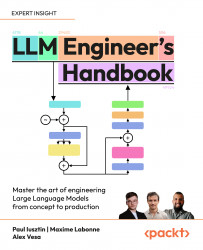The LLM Engineer's Handbook, authored by Maxime Labonne and Paul Iusztin, is a definitive resource for AI engineers, NLP professionals, and developers working with large language models (LLMs)[1][3]. This white paper highlights the handbook's key aspects, its significance in the rapidly evolving field of LLMs, and its practical applications in real-world scenarios. Additionally, it introduces RAGFlow—an advanced workflow framework for optimizing Retrieval-Augmented Generation (RAG) systems—and demonstrates its potential across industries.
White Paper: The LLM Engineer's Handbook - A Comprehensive Guide to Large Language Model Engineering
Executive Summary
The LLM Engineer's Handbook, authored by Maxime Labonne and Paul Iusztin, is a definitive resource for AI engineers, NLP professionals, and developers working with large language models (LLMs)[1][3]. This white paper highlights the handbook's key aspects, its significance in the rapidly evolving field of LLMs, and its practical applications in real-world scenarios. Additionally, it introduces RAGFlow—an advanced workflow framework for optimizing Retrieval-Augmented Generation (RAG) systems—and demonstrates its potential across industries.
Introduction
Large Language Models (LLMs) are transforming the AI landscape, creating unprecedented opportunities for innovation. However, designing, training, deploying, and optimizing these models require specialized skills. The LLM Engineer's Handbook bridges the gap between theoretical knowledge and practical implementation, offering a roadmap for professionals in this field[3].
This white paper expands on the handbook's core ideas and introduces RAGFlow, a structured methodology designed to maximize the efficiency and impact of RAG systems, enabling businesses to unlock the full potential of LLMs.
Key Features of the Handbook
- End-to-End Coverage: The handbook comprehensively addresses the entire LLM lifecycle, from data collection and pretraining to fine-tuning, evaluation, and deployment[1].
- MLOps Best Practices: It emphasizes the role of MLOps in achieving scalability, reliability, and high performance in production environments[1].
- Practical Guidance: Step-by-step instructions are provided for building and deploying LLM-based systems, including Retrieval-Augmented Generation (RAG) systems[1].
- Tools and Frameworks: The handbook covers key libraries and frameworks such as PyTorch, TensorFlow, Hugging Face Transformers, NVIDIA Triton Inference Server, and Ray Serve[3].
- RAGFlow Workflow: This paper introduces RAGFlow, a novel methodology for systematically designing and managing RAG systems to optimize performance and outcomes.
RAGFlow: A Workflow for Retrieval-Augmented Generation
RAGFlow provides a structured approach for developing and maintaining RAG systems, which enhance LLM capabilities by integrating dynamic data retrieval. RAG systems enable LLMs to produce contextually accurate and relevant responses by combining pretrained knowledge with real-time data.
Core Steps in the RAGFlow Workflow
- Query Understanding: LLMs analyze input queries to extract intent and structure, ensuring accurate downstream processing.
- Document Retrieval: Advanced vector search mechanisms (e.g., Pinecone, Weaviate) fetch relevant documents from a knowledge base based on query context.
- Content Fusion: Retrieved documents are combined with the query to create a coherent and context-rich input for the LLM.
- Response Generation: The LLM generates accurate, contextually informed responses.
- Feedback Loop: User interactions and system outputs are logged to refine retrieval models and improve overall performance.
Comprehensive Use Cases
1. Natural Language Processing (NLP) Tasks
- Named Entity Recognition (NER): Using RAGFlow to incorporate domain-specific knowledge for enhanced entity recognition.
- Sentiment Analysis: Applying RAG systems to analyze sentiment with deep contextual awareness.
2. Conversational AI
- Chatbots: Deploying RAGFlow-powered chatbots that dynamically retrieve accurate answers from extensive knowledge bases.
- Virtual Assistants: Enhancing virtual assistants to handle complex, multi-turn queries with real-time retrieval.
3. Content Generation
- Automated Reports: Integrating RAGFlow to generate detailed, data-driven reports in real time.
- Code Suggestions: Assisting developers with context-aware programming help by retrieving relevant documentation or code snippets.
4. Information Retrieval
- Advanced QA Systems: Building question-answering systems capable of addressing nuanced queries by leveraging RAGFlow’s dynamic retrieval capabilities.
- Document Summarization: Summarizing technical or legal documents using retrieval-enhanced workflows for precision.
5. Specialized Applications
- Healthcare: RAGFlow-powered systems assist in retrieving patient histories or medical literature for healthcare professionals.
- Legal Research: Automating legal document retrieval and summarization for faster case preparation.
- Finance: Using RAGFlow to analyze market trends and generate predictive insights based on retrieved financial data.
Implementation and Best Practices
The handbook, combined with the RAGFlow methodology, provides actionable strategies for implementing LLM-based solutions effectively.
- Data Preparation: Comprehensive techniques for collecting, cleaning, and preprocessing data to enhance LLM performance[5].
- Knowledge Base Design: Structuring and optimizing retrieval systems for seamless integration with LLMs.
- Fine-Tuning: Advanced strategies for fine-tuning LLMs, including Direct Preference Optimization (DPO), to improve task-specific performance[5].
- Evaluation Metrics: Frameworks to assess retrieval and generation performance, ensuring system reliability.
- Deployment Strategies: Best practices for deploying RAG systems in scalable, efficient cloud or hybrid environments.
Future Directions
The LLM Engineer's Handbook and RAGFlow outline emerging trends and innovations that will shape the future of LLM engineering:
- Hybrid Multi-Modal Systems: Integrating text, image, and video retrieval to create richer, more versatile responses.
- Bias Mitigation and Ethical Practices: Developing transparent workflows to reduce bias and enhance fairness in AI systems.
- Model Efficiency: Innovations in model compression and inference optimization to reduce computational overhead.
Conclusion
The LLM Engineer's Handbook and the RAGFlow framework together serve as essential resources for mastering large language model engineering. With comprehensive guidance, practical tools, and real-world use cases, this resource equips AI professionals with the skills needed to drive innovation and deliver impactful solutions in today’s fast-paced AI landscape.
References
- Exploring the LLM Engineer's Handbook: A Comprehensive Guide for AI Researchers. (2024, November 23). Textify.ai.
- LLM Engineer's Handbook. (2024). Packt Publishing.
- Labonne, M., & Iusztin, P. (2024). LLM Engineer's Handbook: Master the art of engineering large language models from concept to production. Packt Publishing Ltd.
- LLM Engineer's Handbook. (n.d.). Sciendo.
- SylphAI-Inc/LLM-engineer-handbook. (2024, November 4). GitHub.
- Tahir, H. (2024, October 22). LinkedIn post on LLM Engineers handbook.
- PacktPublishing/LLM-Engineers-Handbook. (n.d.). GitHub.
- LLM Engineer's Handbook. (n.d.). Packt Publishing.
Citations: [1] https://textify.ai/exploring-the-llm-engineers-handbook-a-comprehensive-guide-for-ai-researchers/ [2] https://www.packtpub.com/en-us/product/llm-engineers-handbook-9781836200079/chapter/evaluating-llms-7/section/references-ch07lvl1sec46 [3] https://books.google.com/books/about/LLM_Engineer_s_Handbook.html?id=jHEqEQAAQBAJ [4] https://sciendo.com/book/9781836200062 [5] https://github.com/SylphAI-Inc/llm-engineer-handbook [6] https://www.linkedin.com/posts/hamzatahirofficial_check-out-the-llm-engineers-handbook-by-maxime-activity-7254559179246358528-muBr [7] https://github.com/PacktPublishing/LLM-Engineers-Handbook/activity [8] https://www.packtpub.com/en-us/product/llm-engineers-handbook-9781836200062
